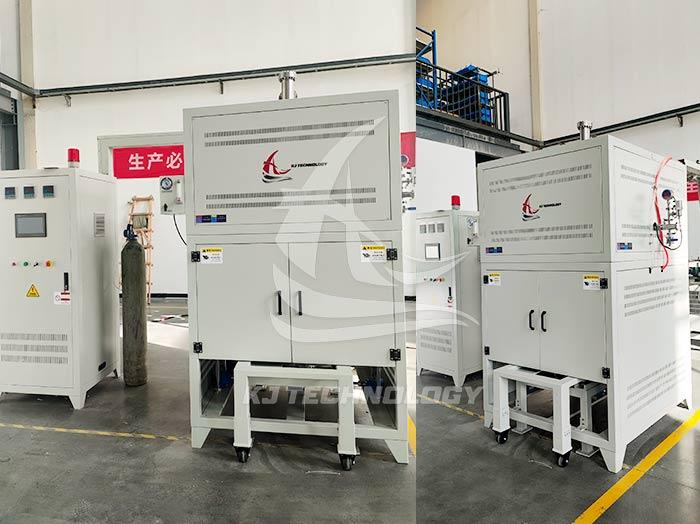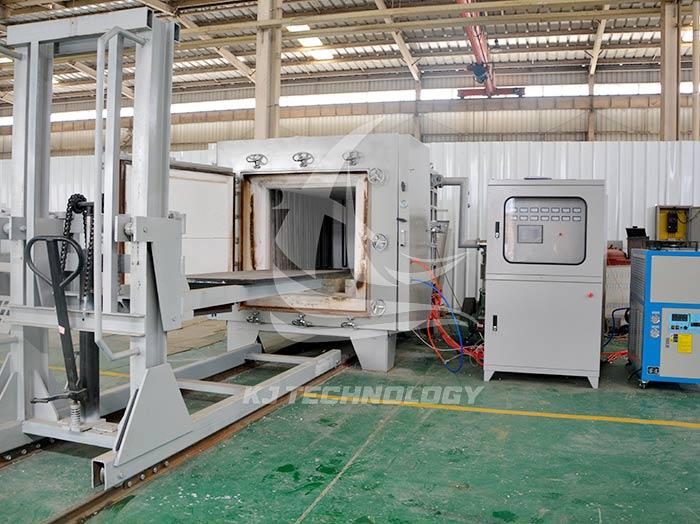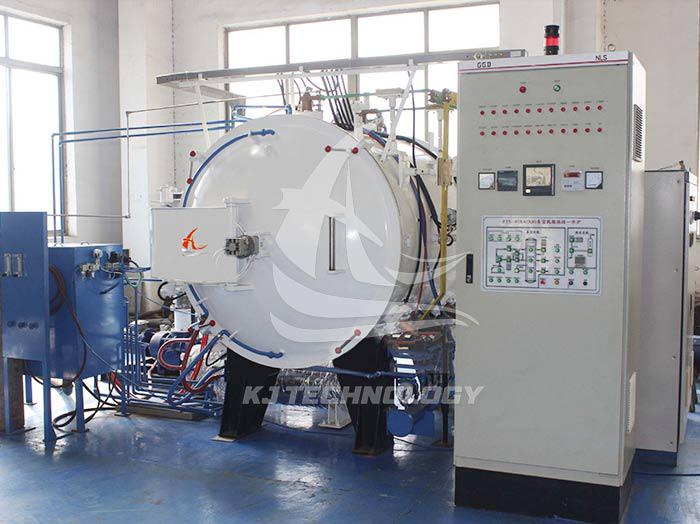What are the application scenarios of box type vacuum muffle furnace?
 05-13-2025 Author: KJ technology
05-13-2025 Author: KJ technology
The box type vacuum muffle furnace has a wide range of applications in material preparation, heat treatment, analysis and testing through the synergistic effect of vacuum environment and high-temperature heating. From the dimensions and core values of materials science, industrial manufacturing, and scientific research analysis:
1. Materials Science and Engineering
Advanced Ceramics and Powder Metallurgy
Application: Non pressure sintering of ceramic materials such as alumina and silicon nitride, vacuum degassing and densification of metal powders.
Advantages: Vacuum environment inhibits oxidation, reduces sintering temperature (such as alumina sintering temperature can be reduced by 100-200 ℃), and improves material density (≥ 98%).
Case: Vacuum sintering of hard alloy cutting tools increases hardness by 15% and significantly enhances wear resistance.
Semiconductors and Electronic Materials
Application: Annealing of silicon wafers, surface purification before epitaxial growth of silicon carbide (SiC), pre sintering of positive electrode materials for lithium-ion batteries (such as NCM).
Advantages: High vacuum (≤ 10 ⁻⁴ Pa) avoids the introduction of impurities and ensures material purity (such as SiC crystal purity reaching 99.9999%).
Data: After vacuum annealing, the carrier mobility of silicon wafers increased by 20%, and the device performance became more stable.
Preparation of composite materials
Application: Interface modification of carbon fiber reinforced ceramic matrix composites (CMC) and co sintering of metal ceramic gradient materials.
Advantages: By regulating the interface reaction through vacuum environment, the interfacial bonding strength of composite materials can be improved (such as increasing the interlayer shear strength of C/SiC composite materials by 30%).
2. Industrial Manufacturing and Heat Treatment
High end metal heat treatment
Application: Vacuum annealing and solution treatment of titanium alloys and high-temperature alloys to eliminate processing stress and refine grain size.
Advantages: Avoid high-temperature oxidation, improve material surface smoothness (Ra ≤ 0.2 μ m), and extend fatigue life by 50%.
Case: Vacuum heat treatment of aircraft engine turbine blades improves temperature resistance by 80 ℃.
Precision casting and 3D printing post-processing
Application: Degreasing and sintering of 3D printed parts of titanium alloy and cobalt chromium alloy, stress relief annealing of precision castings.
Advantages: The vacuum environment prevents metal oxidation, reduces porosity to below 1%, and has mechanical properties similar to forged parts.
Data: After vacuum sintering, the elastic modulus of 3D printed titanium alloy implants increases by 40% in matching with human bones.
Vacuum brazing and diffusion welding
Application: Vacuum brazing of aircraft engine blades and turbine disks, diffusion bonding of dissimilar metals.
Advantages: High vacuum environment reduces weld oxidation, and the joint strength reaches over 90% of the base metal.
3. Research analysis and testing
Material characterization and pretreatment
Application: Vacuum degassing of X-ray diffraction (XRD) samples and surface cleaning before scanning electron microscopy (SEM) observation.
Advantages: Vacuum treatment removes surface adsorbed gases, avoids testing interference, and improves data accuracy.
Case: Vacuum degassing before characterization of nanomaterials resulted in a 30% decrease in background signal and a more accurate peak intensity ratio.
Thermogravimetric analysis and ash content determination
Application: Vacuum thermogravimetric analysis (TGA) of polymer materials and coal, precise determination of ash content in food.
Advantages: Avoid oxidation and weight gain under inert atmosphere or vacuum, with ash content measurement error ≤ 0.1%.
Data: The threshold temperature for graphene oxidation was determined by vacuum TGA, and the error was reduced by 50 ℃ compared to air environment.
Catalysis and Reaction Research
Application: Vacuum activation of catalyst supports, raw material pretreatment for high-temperature gas-phase reactions (such as methane cracking for hydrogen production).
Advantages: Vacuum environment regulates the reaction atmosphere and improves the selectivity of target products (such as increasing methane conversion rate by 15%).
4. Expanding into emerging fields
Development of new energy materials
Application: Vacuum sintering of solid-state battery electrolytes (such as LLZO) and reduction treatment of hydrogen fuel cell electrodes.
Advantages: Avoid lithium/hydrogen element volatilization under high vacuum, and increase ion conductivity by 2-3 orders of magnitude.
Case: Vacuum sintered LLZO solid electrolyte with room temperature ionic conductivity of 10 ⁻ S/cm.
Preparation of Quantum Materials
Application: Vacuum annealing and thin film deposition of topological insulators and high-temperature superconductors.
Advantages: The ultra clean environment ensures the integrity of the material lattice, and the superconducting transition temperature (Tc) is increased by 5-10K.
Data: After vacuum annealing, the surface roughness of Bi ₂ Se Ⅲ thin film decreased to 0.5nm, and the quantum state became more stable.
biomedical engineering
Applications: Vacuum sintering of bioceramics (such as hydroxyapatite), surface modification of medical titanium alloys.
Advantages: Vacuum environment avoids loss of bioactive ingredients and improves material biocompatibility (such as a 40% increase in cell adhesion rate).
5. Summary
The box type vacuum muffle furnace has become a key equipment in the fields of material preparation, industrial manufacturing, and scientific research analysis through the synergistic effect of vacuum environment and high-temperature heating. Its core values are reflected in:
Inhibiting oxidation and pollution: ensuring high purity and performance stability of materials;
Reduce process temperature: save energy and improve production efficiency;
Realize special atmosphere: meet diverse process requirements such as reduction and inertness.
Selection suggestion: Based on specific application requirements, focus on the vacuum degree, temperature uniformity, furnace size, and atmosphere control capability of the equipment, while considering the scalability of the equipment (such as whether it supports in-situ monitoring).








